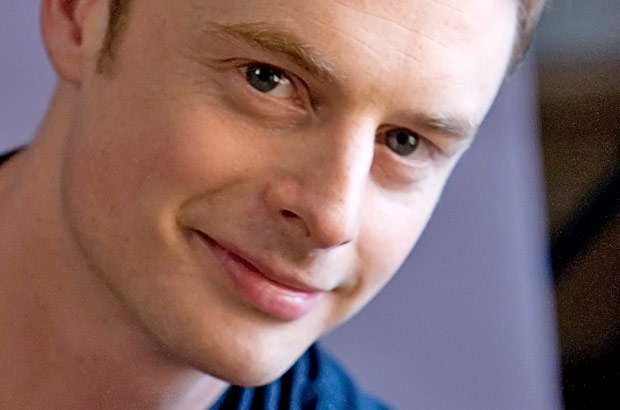
© Rosalie O’Connor. (Click image for larger version)
www.sfballet.org
SFB Cinderella page
Earlier Christopher Wheeldon interviews…
on Balletco…
December 2010
February 2009
September 2006
July 2004
August 2003
Choreographer Christopher Wheeldon is currently at the San Francisco Ballet preparing for the American premiere of his Cinderella. He has a rehearsal in forty-five minutes so we quickly set off to discuss his latest full-length ballet and many other things…
Aimée Ts’ao: And the first question is – why Cinderella?
Christopher Wheeldon: Because it’s a beloved fairy tale. Because it’s a wonderful score. Because it’s a title that people recognize and will buy tickets for. Some people might see the choice of using a well-known title as a sell-out, but I think it’s a product of our economy right now. People like to know what it is that they are going to see.
Originally, we were talking about doing the Prince of the Pagodas here, which I think is also a very interesting score for ballet, but it’s not an easy title to sell. Prokofiev’s music for Cinderella was the big draw for me. It’s one of the great ballet scores written in the last century.
And your personal feelings about the Cinderella story – how did you feel about it as a child? Some people hate certain fairy tales.
No, I loved Cinderella as a kid. I think it’s probably the most universal of all fairy tales. The Cinderella themes find their way into so many different pieces of fiction, even movies that are not classical fairy tales. They weave their way into all sorts of pieces of art. I think it’s a story that everybody relates to. We all grow up with those dreams of finding our version of the handsome prince or princess. It’s probably in the collective blood.
How did Cinderella come to be and how was the process?
Originally it was the Dutch National Ballet (DNB), no, let’s get this right – was it DNB or Helgi who said something first? I know that Helgi was really interested in having a Cinderella here because there hasn’t been one in years.. Because it has such a glorious score and it is a universal fairy tale, it makes sense for SFB because they’ve got everything else – Swan Lake, Sleeping Beauty, Romeo [and Juliet]. We decided in the end to make it a co-production and that’s been an interesting experience to have the creative process in both places.
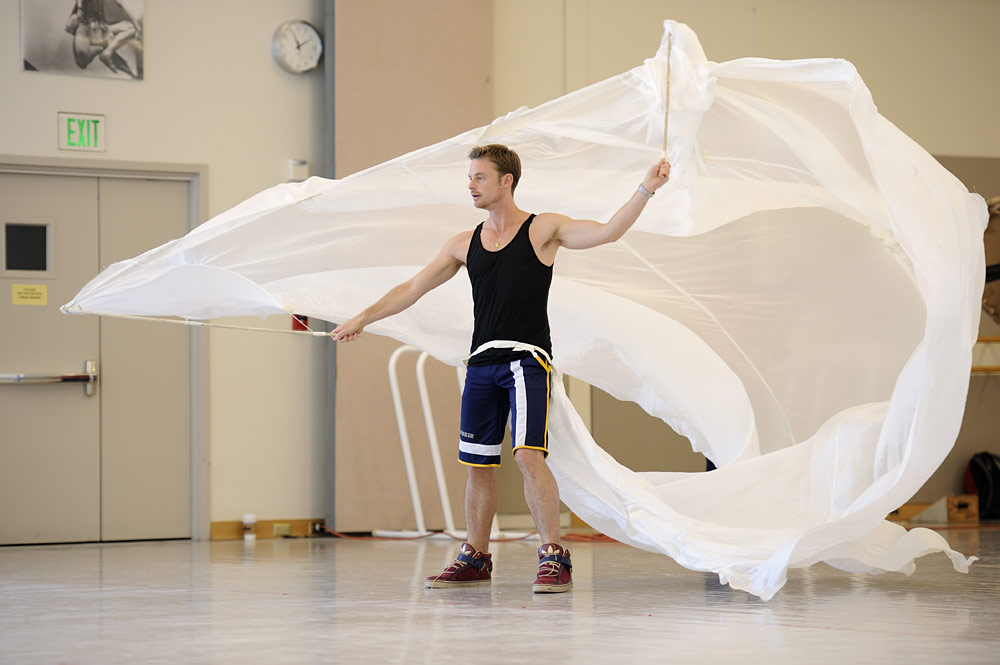
© Erik Tomasson. (Click image for larger version)
Logistically it was more complex because it meant that some of the work I had started here [San Francisco] in the summer, then had to be re-taught there [Amsterdam] before I could continue working, or was being re-taught while I was continuing to work. It was double the work in a sense, but interesting to have that creative experience with two sets of dancers. The DNB dancers had a part in the process, instead of making it all here and premiering it there or vice versa. It allowed the two companies to have the experience of being created on.. That’s what dancers want – to have work made for them. It’s less interesting for them if I just turn up with a finished piece.
The [DNB] dancers adapted very well to the material I’d made here. The two companies are quite similar in their dynamics. DNB has an international style, meaning there are lots of different influences. They are a very physical company. They are probably the most “American” European company I know, in their range and the way that they move. Physical, athletic–so that the choreography I made here actually fits on them quite well.
And we did have some cross-over where for three weeks Masha [Maria Kochetkova and Joan [Boada] and Frances [Chung] and Luke [Ingham] came over [to Amsterdam] and, vice versa, when several couples from DNB came here.

© Erik Tomasson. (Click image for larger version)
I understand that the stepsisters are women in your production and I’d like to know about that choice – so many times they are played by men…
In Ashton and Stevenson. That was Ashton pulling from the British pantomime tradition and then people followed suit. But for me, I went back to several different versions of the story. We didn’t just go with the Perrault version. We built our story with elements from the Brothers Grimm tale and some from the Rossini opera and then some of our own ideas. As you know from the Perrault and Brothers Grimm, which is the darker version, the sisters are really nasty. I think they should be Cinderella’s contemporaries, they are all about the same age so it makes sense to use women. In the Grimm version, they aren’t ugly physically, just their personalities are. In fact, in my version, one of them is really beautiful and very spiteful and the other is not quite as pretty, but a little bit sweeter. I find it more interesting to have some contrast between the characters because Prokofiev has an enormous amount of bickering going on in the music. I felt there needed to be more balance.
Cinderella is a huge undertaking – most people don’t have a clue how much work goes into such a ballet. So how was it for you?
I’ve thought a lot about that. That people don’t understand the amount of work and the amount of stress. All those light-bulb moments that happen in the studio with the dancers as you’re going along. But it’s two very different experiences. It’s never going to be that way for the public. For the most part, people who go to the theater buy a ticket. They don’t really care what’s happened prior to or what’s happened after. They bought that ticket to see that moment on stage. I was thinking about that recently. I’ve always been like you, excited about process and letting people know and letting people in. Now we can do even more, especially with the media. The Royal Ballet did their “Day at the Royal Ballet” live streaming online. There are a lot of process films of different [dance] companies online showing the making of ballets. We made about five or six in Amsterdam about Cinderella, on the roles of the stepsisters, and all the design elements. I think many companies now have the staff and a film department to do those sorts of things. San Francisco Ballet does a very nice job of it with their artist profiles on the website. Now there is more for the audience to look into. If they want to see an interview with me about Cinderella they can go online and click on a link.

© Angela Sterling. (Click image for larger version)
But the general public, more often than not, will not look further. The people who love ballet will, but those who have never been to the ballet, or have only been once, those who aren’t afficionados, only want to see that one moment [on stage].
Don’t you think that young people who use social media a lot would be more likely to be checking into all the background information?
Yes and no, except there is so much out there for us to be checking into all the time and they have things they are really interested in checking out. That’s part of the problem today – there’s just too much to be checking into.
The big hope is that there will be a lot for people to look into, but hopefully they will come back [to see it] and they will become the afficionados. That’s what I try to achieve and I think I’ve been quite successful with Alice [in Wonderland]. It was a great introduction to ballet for many people. It’s becoming a work that can be used by both the Royal Ballet and the National Ballet of Canada to attract new audiences and bring more people in. Cinderella is similar in that sense. It’s very much a ballet of today’s dynamic and energy. It’s quite rich with story and moves more like a film than a conventional ballet. Only having done it in Amsterdam, it seems to have captured those audience members in a way that I hope will encourage them to come back and see other programs.
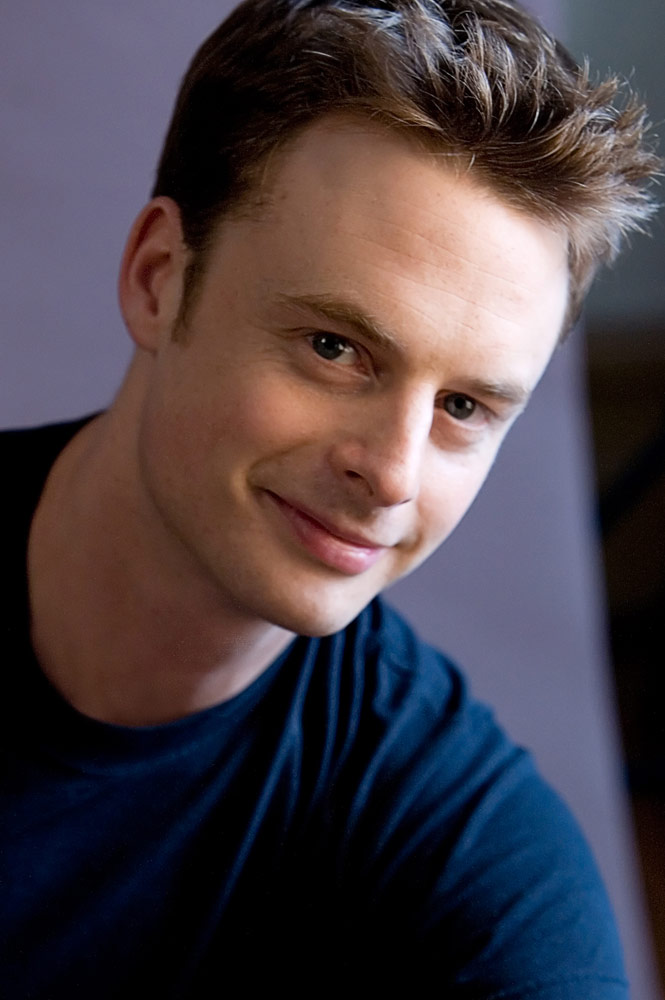
© Rosalie O’Connor. (Click image for larger version)
I think that is really important because so many people think of Nutcracker as the first ballet you take your children to.
Well, there is no real story to the Nutcracker. Kids get bored. On the other hand, kids like to be scared a little bit. You have to have the right balance of dark and light in a fairy tale ballet and not be afraid to have something a little bit grotesque or a little bit dark. That’s much more a European sensibility. Growing up on children’s theatre in England and the kind of theatre my parents would take me to, I see it was less sanitised than a lot of the children’s theatre I’ve seen in this country.
I’d like to ask you about future projects…
In the near future I’m headed back to New York for a new piece, a duet, at New York City Ballet (NYCB) for their spring gala and an old piece I made for the school in 1995 which we’re now putting on the young dancers in the company. Following that I go to Seattle for three weeks at PNB (Pacific Northwest Ballet) where I’m setting a new piece for about six couples. Music is by a composer named Joby Talbot. SF Ballet has done Chroma [a ballet by Wayne McGregor], right? He wrote the music for that.
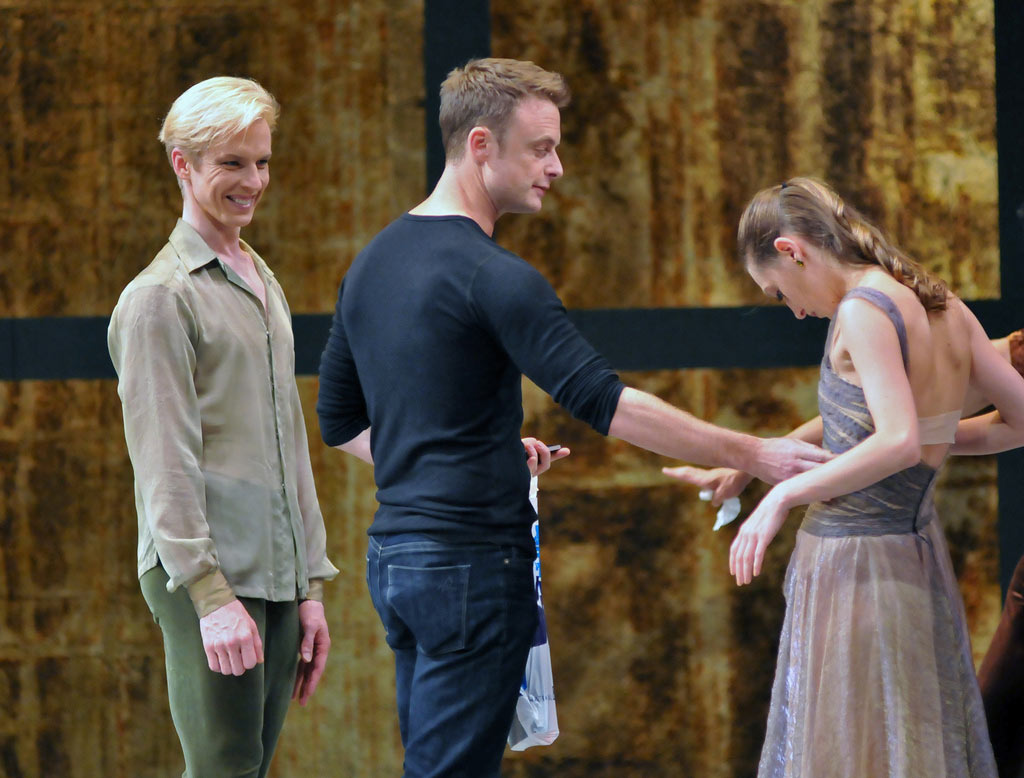
© Dave Morgan and courtesy of San Francisco Ballet. (Click image for larger version)
I’m also working on a project we’re developing for Broadway. That’s down the road a bit but I will be starting with the preliminary development this summer. It’s an old-fashioned musical with a lot of dancing in it. It’s an old idea that’s never been on the stage. I apologise for being cryptic, but I can’t announce anything right now. It’s an old movie actually. It’s being rewritten so the book is brand new.
And Cinderella goes to New York in the fall with this company so I’ll be around for that and also some revivals for NYCB.
Then I’m back to the Royal Ballet in January to start a new piece that will open in April. A new full-length, The Winter’s Tale. With a new score by Joby [Talbot], thank God. That’s the big premiere next year. It’s going to be a big production and we’re in the very early stages of getting the score written. And we haven’t designed it yet. We have only a rough synopsis guide. It will mostly be what can be most convincingly shown through physicality, boiling it down to an essence.
Change of subject – where did you grow up in England?
As a child I grew up in Somerset which is southwest of London. Rural, lovely pastoral place. But then I started going up to London for ballet classes when I was eight so the ten years between eight and moving to America I was in London.
I was curious to know if you grew up in a large urban center or a smaller city.
It was a mix of both. I was also lucky because my parents loved, and still love the theatre. My father just started directing amateur dramatics. When I was growing up, it was still at a time when the big companies in England toured the provinces. I saw the Royal Ballet, and the Royal Shakespeare [Company] came through. Some of them still do, but unfortunately the funding isn’t there anymore for the Royal Ballet and the English National Ballet to get around the country. They do a bit, but it’s not the same as when I was young. We would have a pretty substantial Royal Ballet season, or at least two major visits a year. We also weren’t that far from London and would go up there often to see performances.
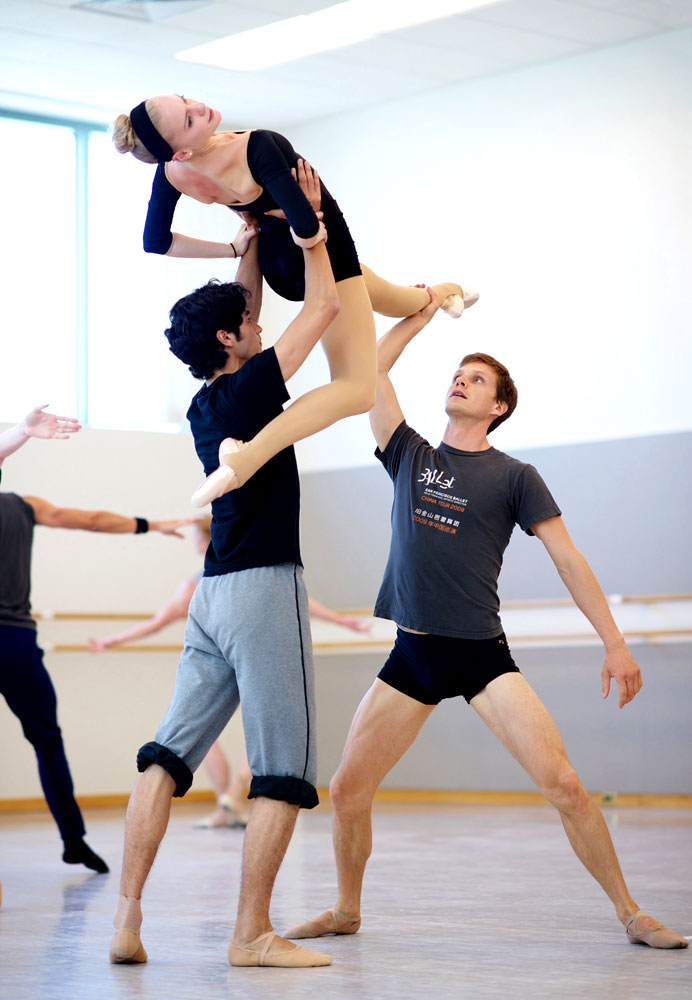
© Erik Tomasson. (Click image for larger version)
In this country, the touring has virtually stopped. It’s unfortunate because people and dancers don’t have that “food” and you need it to grow as an artist.
Yes, the dancers in SFB are very good about that [getting out to see things]. The dancers in New York tend to get a bit lazy because it’s all there and suddenly you wonder, why aren’t they out seeing all these wonderful companies. Like Nederlands Dans Theater. Unfortunately they had only two shows in New York because it is so expensive to be there. There were so few dancers at their shows. Perhaps because of where I was sitting I couldn’t see, but I felt that because there were only two shows, I should have seen half of American Ballet Theatre and half of New York City Ballet there.
I was very lucky because my parents took me to see a lot of puppet theatre and other performances. They knew how important it was for me. And at the time, arts in the schools was still important. By teaching your child music, by teaching dance and art, you made them a better mathematician, a better reader. It’s so unbelievable in this country that they don’t see that. There is so much mathematics in music, literature and art.
The real question is how to move forward in the future. In twenty years, what are all the young dancers going to be bringing to you in the studio.
There does seem to be a swing back toward classical ballet choreography. I’m seeing that more and more, not only in the appreciation of the public, but also in the young choreographers who are starting to be pushed forward now, are all classical choreographers. There was a time when the voice of Forsythe and the voice of Kylian was so strong and had such a strong influence on young choreographers that everyone was following them and now it seems that the younger generation of choreographers coming out of ballet companies are going back toward making ballet, which is exciting. Liam Scarlett in London, who I think is coming here next year, and Justin Peck in New York and Alexei [Ratmansky] are all doing classical choreography. I was feeling like I was the “last of the Mohicans” because I was alone. Although I was very influenced and still am influenced by Balanchine, and Forsythe and Kylian, because they were what was happening, I still feel I want to push for ballet. It seems like we’re a team all pushing the same way, which is encouraging

© Erik Tomasson. (Click image for larger version)
I think that people suddenly see that you can have something emotional on stage. If the dancers are just flailing around and making shapes it’s usually not happening.
I think we understand how incredibly physical dance is and how incredibly technical it can be, and these guys can do everything. But there was a time when it was very impressive to see high extensions lots of turns and incredible feet. When I was at school and Sylvie Guillem and Darcey Bussell first came on the scene, they had this physicality that hadn’t been around before. And now so many can all do that; all the legs are high and all the turns are many.
For me, it’s not about the athleticism of it, it’s about the human part of art – that’s how you touch people.
Yes, and the storytelling within the abstract is important as well. We can all put on an impressive display of movement, we all know how to do that, but finding emotional resonance in the abstract is really very difficult. A real choreographer is someone who knows how to put steps together to the music that doesn’t necessarily explain anything in particular to the audience or whoever is watching, but there is just something about the way the movement and the dancers interact that creates a tension or a breathlessness. Some of the ballets that I have had success with over the years have emerged from no real plan but are just a way of finding how the shifting of shape and the interaction of people can create that. It’s certainly not just about sculpture. Ballets find their own stories.
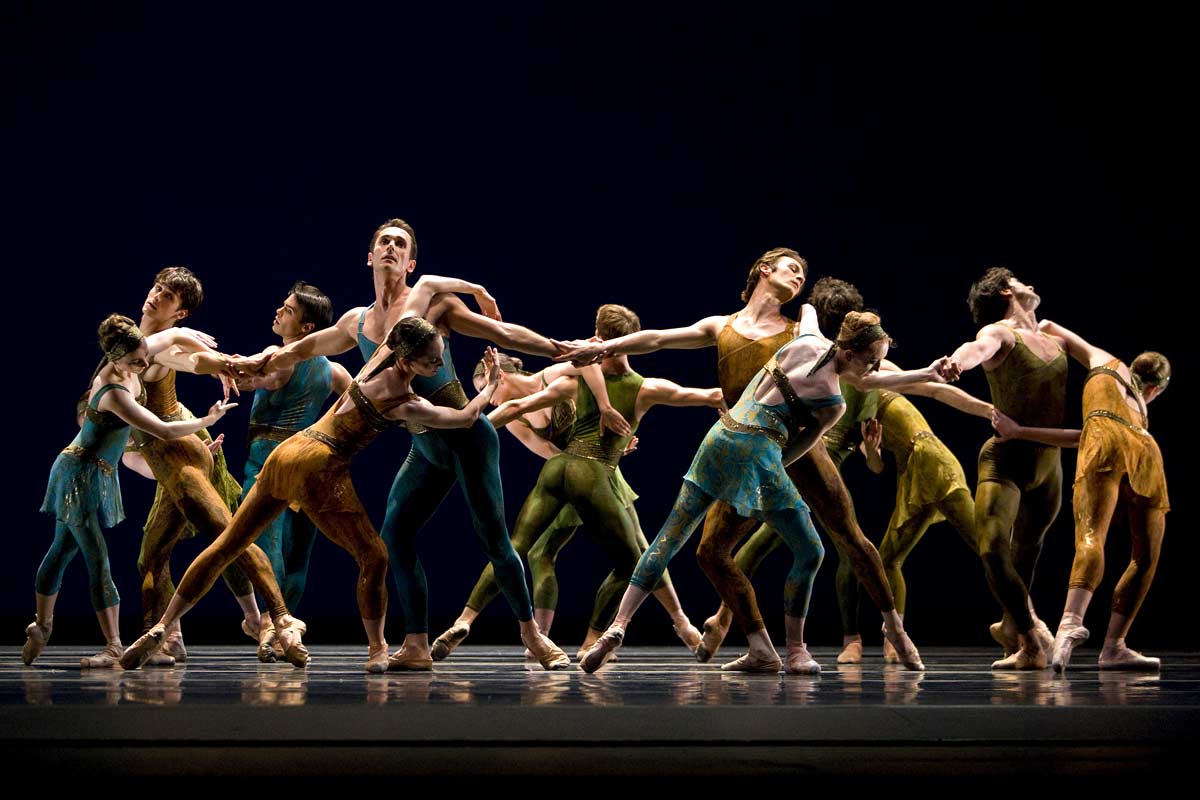
© Erik Tomasson. (Click image for larger version)
Just a month ago when SFB was dancing Within the Golden Hour I just couldn’t believe what was happening on stage. Somehow all the dancers had risen together and whatever they were doing was like magic.
It’s so beautiful when that happens; it’s so special. It doesn’t happen that often, but it happens more often with this company than with any other company I’ve worked with. There’s a magic about this company. Even in work that isn’t so interesting. I guess they just work so well together, they understand each other. They have a collective energy about them and I’m so impressed. They get on with the work. Not to be down on any of the other companies that I work with because I love them all with their various quirks, but this company has a way of getting on with the job with less fuss, so they have more energy to find those connections on stage. It’s impressive. And saying that, I have to get on now and go rehearse with them!

© Angela Sterling. (Click image for larger version)
Cinderella premieres on Friday, May 3 and continues through Sunday, May 12. Details.







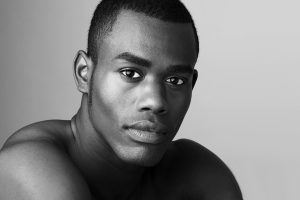



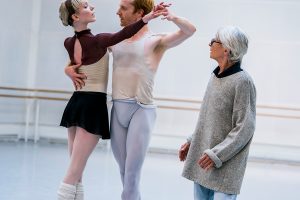



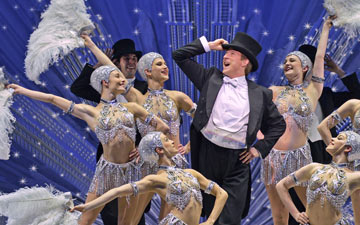
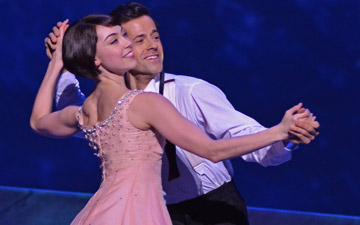
What a great interview! Looking forward to his Cinderella.